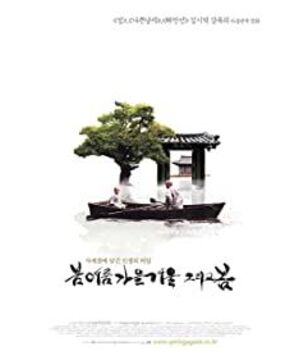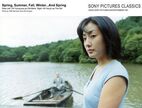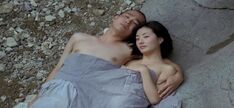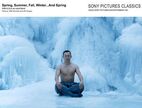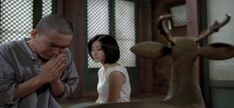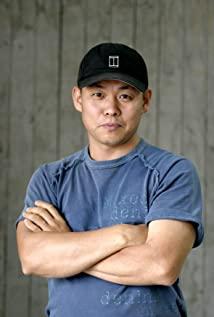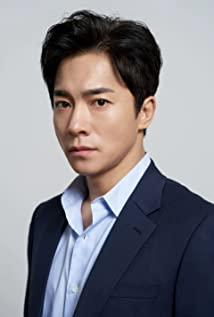"Seven emotions and six desires" disturb people's body and mind, stagnate in their hearts, and cover their minds like a fog, so that they are "obsessed" and have many troubles.
The only way to liberation is to annihilate worldly desires, that is, to annihilate human desires. This is the "truth of annihilation".
Find the source of suffering, annihilate worldly desires, eliminate all afflictions, practice diligently according to the "Eightfold Path" guided by the Buddha, enter the "Nirvana" state of no desires, no desires, and no worries, and obtain complete spiritual liberation , this is the "truth". Starting from the understanding of the "suffering truth", step by step deriving "the truth of collection", "the truth of cessation" and "the truth of the Tao", this is a kind of rational thinking, which is the Buddhist understanding and understanding of how to get out of the "sea of suffering" in life.
Chun (Little Monk)
There is a door where the little monk sleeps, and another door after crossing the river, and these two doors are not surrounded by walls as usual, but only a single door, this door seems to indicate that Constrained by human nature, no matter how wide the road beside the door, the young monk and the old monk still choose to pass through the door, which means that they follow the rules and are bound by their inner human nature.
The little monk played with fish, frogs and snakes in the river, and tied the fish, frogs, and snakes with pebbles and strings. This is because he was influenced by the environment as a kind of self-restraint since he was a child, but he imposed this restraint on the Others, it means that he is being restrained, rather than actively choosing restraint, just like fish, frogs, and snakes, there is actually a foreshadowing that the little monk will change. There will eventually be letting go and liberation.
The punishment of the old monk is also to warn the young monk to seek the inner blessing of himself, rather than to force himself to be restrained by means of external requirements. The path of liberation in life guided by it is internal, ego, and spiritual. To put it bluntly, it means "saving oneself by oneself". The punishment of the old monk is actually to teach the young monk to learn a kind of "sympathy" from the heart, to regard the suffering of fish, frogs, and snakes as their own suffering. This is not self-blame out of conscience, but a kind of completely from A sense of responsibility from within.
Xia (Young Young Monk)
The snakes are mating, the river is rising, and the young monk is surging with youth. The girl who came to ask for his life because of illness arrives, which makes the young monk who is in adolescence feel ready to move. He tried to attack the girl twice but failed. The body and the heart are restless Anxiety made him madly rowing in the river, and after enjoying the fish and water with the girl, his inner desire for sex became more and more. The young monk avoided the door and chose the door to go out while the old monk was asleep. , The little monk broke his precepts by abandoning the restraint of more than ten years based on the desire to expand his body instinctively. The relationship between the two was broken by the old monk. The old monk warned the young monk that everything has a destiny. People need to follow the laws of nature, but they should not have greed. Put water on the bed as a warning. , to lose oneself, this is the truth of suffering. The young monk chose to take the Buddha away, but the old monk was still knocking on the wooden fish in the face of the empty wall, and it was with the intention of the Buddha—there was Buddha freedom in his heart, and the Buddha wanted to make peace, but the young monk had not yet achieved spiritual liberation. Buddhism regards people's "emotion" and "desire" as the source of suffering and troubles, and requires people to give up utilitarianism and "kill people's desire". This is the reason for "do not leave the worldly way, always follow the worldly way".
Qiu (the young monk is already a middle-aged monk)
The young monk got married after going out, but killed his wife. This is Jiji. The old monk seemed to have foreseen that he would sew up the little monk's robe and wait for the little monk to return. The old monk found that the young monk who came back was full of rage after walking around the world. He couldn't let go of his anger. The young monk took a blood-stained knife and stabbed it on the wooden floor. When he was angry that he didn't know his heart was closed, he closed his body and beat him with sticks. At this time, the police found the young monk who killed his wife. The young monk was still full of anger and vigilance, but after listening to the old monk's words and writing the Prajnaparamita Sutra, the young monk's state of mind It began to slowly turn from anger to calm, and the blood stains on the knife disappeared, which means that the little monk has washed away the lead in his heart, began to let go and liberate, and achieved the desire to destroy the world, that is, the truth of extinction. In the morning, the old monk painted the characters engraved by the young monk in color, and the police who came seemed to be influenced and helped to paint them, green, orange, purple and blue, which seemed to be the colors of each season, warning the young monk that there was a reason for it. There must be fruit, life is cyclical. The little monk and the police left by boat, and the boat stopped for a while. This was the old monk's reluctance to the young monk. Because the old monk knew that his time was short, the old monk burned himself after the young monk left.
Winter (older young monk)
When the little monk came back, the old monk had turned into a relic and opened the door. The little monk saw a snake sitting cross-legged in the old monk's robe. The rebirth of an old monk. The tempering of time has made the little monk transcendental. He seems to have given up everything to get his own liberation. He carved a Buddha and hid the old monk's relic in the Buddha's head. In the young monk's heart, the old monk has become a Buddha. , he followed in the footsteps of the old monk and continued to transform himself. At this time, a masked woman came to the temple with a child, which seemed to indicate that an old monk and a young monk would appear again, and it would be a cycle of rebirth. As for why the woman brought a mask, it may be Tuo Guzhi She was ashamed to face it, or maybe this woman was the one who was sick at the time. The reason why he worshipped Buddha in the ice cave was because this woman was the beginning of his suffering. Practicing martial arts and dragging it with stone grinding are the essence of the Tao. This corresponds to the beginning and end of the previous spring, and it also implies the cycle of cause and effect, the principle of reincarnation.
When the young monk was young, the old monk and the young monk depended on each other for life. When the young monk grew up, the old monk seemed to have foreseen the young monk's departure and raised chickens. I got a cat. In the end, when the police took the little monk to leave, the cat also left. Everything was like fate. In the film, there are two lines of tears in autumn and winter, one is a young monk who kills and returns to post closed words, one is an old monk who burns himself, and another is a woman wearing a veil and leaving a child. These all show that everyone's life is one. The process of getting rid of suffering, and the old monk's relic finally escaped from the ice sculpture of Buddha and flowed into the water, as if he had gotten rid of his suffering, and was "imprisoned" in a nunnery all his life, and finally he was also seeking a kind of free detachment after death.
In Buddhism, the world is boundless, time is infinite, it has past, present and future. This view of time and space is obviously correct, but for limited life, "past life" and "next life" are just religious concepts, and do not have the meaning of "real existence". Its theory is "karma reincarnation", which holds that people's "karma" (what they do) will produce different results (i.e. retribution), that is, "good will be rewarded with good, evil will be rewarded with evil, no memory (no action) without Retribution.” This causal relationship repeats itself in the “three lives”, the effect of the “past life” is the cause of the “present life”, and the effect of the “present life” is the cause of the “next life”, which is called “three times of double cause and effect”. Although "reincarnation" is illusory, it seems to give people a warning, telling people to do more good deeds and not to do evil, but it is also conducive to people's "self-control", which is good for social governance.
View more about Spring, Summer, Fall, Winter... and Spring reviews


